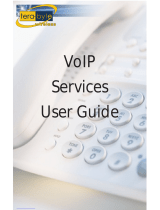
R44-450 v1.0 TelNet OfficeEdge Complete Reference | 3 |
Conference Calls
To conduct conference calls:
1) Call the first party.
2) From Lines or Active Call View, press More, then Confrnc.
3) Dial the other party and press Send. Wait for other party
to answer and then press Confrnc.
From Lines or Calls View, you can:
Press Hold to hold the conference.
Press End Call to end the conference.
Press Join to join together two held calls.
Timesaver: Placing Conference Calls
If you have an active and a held call, press More, then
Join to set up a conference.
Paging and Intercom Features
Intercom
To intercom an extension (connect directly to other party’s
speakerphone)
1) Press More, then Intercom from Lines View.
2) Dial the number to which you wish to intercom, then
press Enter.
NOTE: If you are receiving an intercom call, the phone beeps,
then the caller automatically connects to your speakerphone.
Zone Paging (If Enabled)
Zone Paging enables you to intercom to all extensions in a pre-
defined group at once.
1) Press More, More, Paging
2) Select the group you want to page, then press Page.
3) You can then begin speaking.
NOTE: If you are receiving a paging call, the phone beeps, then
caller automatically connects to your speakerphone.
Viewing Recent Calls
To view your Recent Calls list
1) Press Menu button and press Select softkey (with
Features option highlighted),
2) Press down arrow three times to highlight Call Lists and
then press Select softkey.
3) Press down/up arrows to navigate to Missed Calls,
Received Callls or Placed Calls.
4) Press down/up arrows to navigate to desired call.
While in Lines View:
1) Press down navigation button for missed calls
2) Press left navigation button for received calls
3) Press right navigation button for placed calls
Select the desired call record and press Dial.
Contacts
Contact Directory
To view your directory
1) Press Menu button, followed by Select (Features is
highlighted).
2) Press down arrow twice to highlight Contact Directory.
3) Press Select.
To add a contact
1) Press More, then press Add.
2) Type the contact’s information, and press Save. The
phone number should be added to the Contact field.
To make a contact a Favorite
1) Press and hold the desired line key.
2) Enter the contact’s information and press Save. The
phone number should be added to the Contact field.
To update contact information
1) Navigate to your Contact Directory and select the contact.
2) Press Edit, update the contact’s information, and press
Save.
To delete a contact
1) Navigate to your Contact Directory and select the contact.
2) Press More, press Delete, and press Yes to confirm.
To search for a contact
1) Navigate to your Contact Directory and press More, then
press Search.
2) Enter search criteria, and press Search.
To dial a contact from your directory
1) Navigate to your Contact Directory and select the contact.
2) Press Dial.
Notes
Monitored Lines (BLF Keys) are part of an optional add-
on, and are managed by your phone system
administrator. Up to 2 can be configured.
Line Appearance Keys (2 standard) can independently
handle live calls. With the add-on up to 1 Line
Appearance Keys can be configured. These are also
managed by your phone system administrator.
ACD Call Queues (If Enabled)
To log into a Call Queue
1) Press More, More and then press ASignIn. When you are
signed into a call queue, a green icon will be displayed
next to your line.
To log out of a Call Queue
1) Press More, More and then press ASignOut. After logging
out, a gray icon will be displayed next to your line.
To change your agent state to unavailable while logged in:
1) Press More, More and then Unavailable.
2) Press the status that best describes the reason for not
being available (e.g., out to lunch, in a meeting, etc.).









